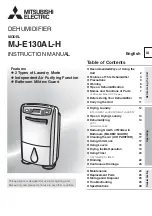
4
www.thermastor.com • [email protected]
Toll-Free 1-800-533-7533
2.10 Low Pressure Control
If the low side refrigerant pressure drops to 5 PSIG, the
low pressure control opens and shuts off the compressor
and blower. It is an automatically reset control. Its primary
function is to prevent damage to the compressor if a leak
develops in the refrigeration system. It may also open if
the unit is A) used in a cool area (below 50°F) and the
defrost timer is not adjusted (see Sec. 2.9) or B) stored
where it is below 40°F and then started. Under these
conditions, the unit will restart within several minutes; it
may cycle several times until the unit warms up.
3 Maintenance
3.1 Air Filter
The Phoenix 200 MAX is equipped with a pleated fabric air
filter that must be checked regularly. The standard filter
is a MERV- high efficiency filter. Operating the unit with
a dirty filter will reduce the dehumidifier’s capacity and
efficiency and may cause the compressor to cycle off and
on unnecessarily on the defrost control.
The filter can generally be vacuumed clean several times
before needing replacement. Replacement filters can be
ordered from the factory or purchased locally if available.
DO NOT operate the unit without the filter or with a less
effective filter as the heat exchange coils inside the unit
could become clogged and require disassembly to clean.
3.2 Storage
There are two issues to consider when the Phoenix 200
MAX is stored between uses and both pertain to the
water trapped in the unit: damage caused by freezing or
biological growth. The effect of the trapped water can be
greatly reduced if precautions are taken to remove as
much as possible before storage.
. Use the pump purge switch (see Sec. 2.7 & Fig. 4) to
reduce the water level in the reservoir.
2. Stretch the hose flat to drain it completely. Walk under
out of the hose to open end.
If the unit will not be exposed to freezing temperatures, an
alternative to reduce biological growth is to flush the unit
with a bio-fungicide that is approved for use with copper,
aluminum and polyethylene. To flush:
. Run the hose to a drain.
2. Plug in the unit but do not turn it on.
3. Remove the air filter. Slowly pour a quart of the
chemical through the heat exchanger
4. Hold in the pump purge switch to reduce the water
level in the reservoir.
5. Flush with water.
4 Service
CAUTION: Servicing the Phoenix 200 MAX with its high
pressure refrigerant system and high voltage circuitry
presents a health hazard which could result in death,
serious bodily injury, and/or property damage. Only
qualified service people should service this unit.
4.1 Warranty
A warranty certificate has been enclosed with this unit;
read it before any repair is initiated. If a warranty repair
is required, call the factory first at -800-533-7533 for
warranty claim authorization and technical assistance.
4.2 Technical Description
The Phoenix 200 MAX uses a refrigeration system similar
to an air conditioner’s to remove heat and moisture from
incoming air, and to add heat to the air that is discharged
(see Fig. 2).
Hot, high pressure refrigerant gas is routed from the
compressor to the condenser coil (see Figure 2). The
refrigerant is cooled and condensed by giving up its heat
to the air that is about to be discharged from the unit.
The refrigerant liquid then passes through a filter/drier
and capillary tubing which cause the refrigerant pressure
and temperature to drop. It next enters the evaporator
coil where it absorbs heat from the incoming air and
evaporates.
The evaporator operates in a flooded condition, which
means that all the evaporator tubes contain liquid
refrigerant during normal operation. A flooded evaporator
should maintain constant pressure and temperature
across the entire coil, from inlet to outlet.
Figure 2: Refrigeration system of Phoenix





























